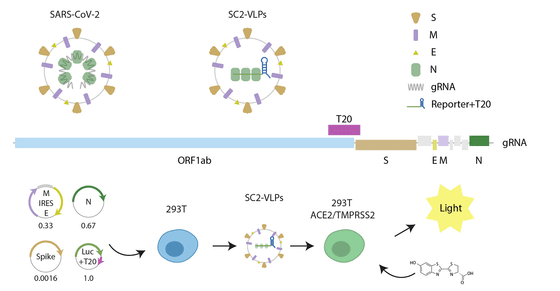'The reason why the new Corona Delta strain is highly infectious' was found in research that produces particles similar to viruses, and it is shining light on the development of a new drug to counter the Delta strain

Regarding the delta strain of the new coronavirus, it is extremely infectious, such as
Rapid assessment of SARS-CoV-2 evolved variants using virus-like particles
https://www.science.org/doi/10.1126/science.abl6184
Why is Delta so infectious? New lab tool spotlights little noticed mutation that speeds viral spread | Science | AAAS
https://www.science.org/content/article/why-delta-so-infectious-new-lab-tool-spotlights-little-noticed-mutation-speeds-viral-spread
So far, research on 'what kind of effect the mutation in the genome of the new coronavirus has' has been focused on the study of peplomer (S protein) on the surface of the virus. The reason is that experiments that deliberately mutate the real new coronavirus require advanced laboratory facilities with biosafety level 3 equipment, and the lentivirus has been used instead. Lentivirus, which can express S protein such as new coronavirus by rearranging the genome, has been used for research on new coronavirus as 'pseudovirus'.

However, lentivirus has the disadvantage that it can synthesize the S protein of the new coronavirus but not other proteins.
In developing VLPs, the research team first focused on a region of the genome called 'T20' that is involved in the synthesis of structural proteins of the new coronavirus. A plasmid made from T20 was introduced into experimentally cultured human-derived cells to complete the new coronavirus virus-like particles (SC2-VLP).

Since this SC2-VLP has four types of
The research team, which succeeded in developing SC2-VLP, then made various mutations in the virus particles. As a result, it was found that the mutated SC2-VLP called 'R203M' found in the delta strain of the new coronavirus illuminates cells several times brighter than when it is not mutated. This 'R203M' mutation is not the S protein of the new coronavirus, but the nucleocapsid protein (N protein) that acts as a shell that protects the genome.

In experiments with SC2-VLP, the research team found that mutations in the N protein increase infectivity, and found that the new coronavirus that actually artificially mutated R203M was applied to the lungs in an environment with appropriate biosafety levels. Infected the cells of. As a result, it was confirmed that the new coronavirus mutated in R203M is 51 times more infectious than usual. 'We found that this mutation in the Delta strain increased the ability of the virus to make infectious particles and spread the infection more quickly,' Saeed said of the results.
In addition, the newly developed SC2-VLP will enable researchers who do not have equipment with a high biosafety level to investigate the behavior of the four structural proteins of the new coronavirus. That's why Jasmine Chubuk of the University of Washington, who was interviewed by Science magazine, where the paper was published, commented, 'SC2-VLPs are a very attractive and powerful tool.'
The researchers are now elucidating how mutations in the N protein found in the Delta strain enhance the infectivity of the virus and investigate what proteins the mechanism is involved in in human cells. It's a schedule. If this identifies the protein in question, it is expected that it will be possible to develop new drugs that suppress the spread of Delta strains.
Related Posts:
in Science, Posted by log1l_ks







